Papers by Pennapa Chonpathompikunlert
Sains Malaysiana, Feb 29, 2024
Acta Biomaterialia, Jun 1, 2020
This is a PDF file of an article that has undergone enhancements after acceptance, such as the ad... more This is a PDF file of an article that has undergone enhancements after acceptance, such as the addition of a cover page and metadata, and formatting for readability, but it is not yet the definitive version of record. This version will undergo additional copyediting, typesetting and review before it is published in its final form, but we are providing this version to give early visibility of the article. Please note that, during the production process, errors may be discovered which could affect the content, and all legal disclaimers that apply to the journal pertain.
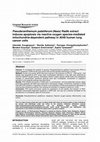
Tropical Journal of Pharmaceutical Research, Mar 12, 2019
Purpose: To investigate the capacity of aqueous Pseuderanthemum paltiferum leaf extracts (PPA) to... more Purpose: To investigate the capacity of aqueous Pseuderanthemum paltiferum leaf extracts (PPA) to induce apoptosis in A549 human lung cancer cells and the possible mechanisms of action. Methods: Human lung cancer A549 cells were cultured in the presence of PPA (0-1000 µg/mL). Cell viability was assessed by MTT assay while morphological alterations in the cells were observed by Hoechst 33342/PI double staining. Intracellular reactive oxygen species (ROS) levels and subsequent changes of mitochondrial membrane potential were also investigated. Involvement of caspase-3 activation in the apoptotic pathway was determined. Results: PPA inhibited the growth of A549 cells in a concentration-and time-dependent manner. Major phenotypic apoptotic cell death was evidenced in microscopic images. Furthermore, treatment of A549 cells with PPA resulted in a significant increase in the production of ROS accompanied by attenuation of mitochondrial membrane potential, thus inducing the activation of caspase-3 activity (p < 0.05). Conclusion: PPA exerts anti-cancer activity by suppression of cell viability and induction of ROSmediated mitochondrial dependent apoptosis in A549 cells, and may be a potential candidate for the development of a therapeutic agent for lung cancer.
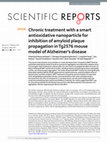
Scientific Reports, Jun 19, 2017
The present study aimed to assess whether our newly developed redox nanoparticle (RNP N) that has... more The present study aimed to assess whether our newly developed redox nanoparticle (RNP N) that has antioxidant potential decreases Aβ levels or prevents Aβ aggregation associated with oxidative stress. The transgenic Tg2576 Alzheimer's disease (AD) mice were used to investigate the effect of chronic ad libitum drinking of RNP N solution for 6 months, including memory and learning functions, antioxidant activity, and amyloid plaque aggregation. The results showed that RNP N-treated mice had significantly attenuated cognitive deficits of both spatial and non-spatial memories, reduced oxidative stress of lipid peroxide, and DNA oxidation. RNP N treatment increased the percent inhibition of superoxide anion and glutathione peroxidase activity, neuronal densities in the cortex and hippocampus, decreased Aβ(1-40), Aβ(1-42) and gamma (γ)-secretase levels, and reduced Aβ plaque observed using immunohistochemistry analysis and thioflavin S staining. Our results suggest that RNP N may be a promising candidate for AD therapy because of its antioxidant properties and reduction in Aβ aggregation, thereby suppressing its adverse side effect. The number of patients affected with Alzheimer's disease (AD) is increasing 1. AD is a slow progressing, neurodegenerative disorder, which exhibits the cardinal hallmarks of amyloid beta (Aβ) plaques accumulation and neurofibrillary tangles. In addition, the loss of synapses, atrophy of the cerebral cortex, neuroinflammation, and increase in free radicals in patients with AD is also reported 2. In the progression of AD, the conformation and misfolding of Aβ proteins causes them to clump together into small oligomers, protofibrils, and mature fibrils 3. The soluble oligomers are structurally heterogeneous, which have been determined as the main toxic forms in AD 4. The oligomer-induced toxicity of the cell is related to its ability to permeabilize cellular membranes and lipid bilayers 5 to form distinct pores or single channels in the membranes 6 and disturb intracellular calcium homeostasis, leading to oxidative stress including overproduction of reactive oxygen species (ROS), altered signaling pathways, mitochondrial dysfunction, and neuronal death 7 .
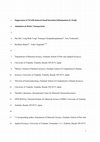
Biomaterials, Nov 1, 2013
Patients regularly taking non-steroidal anti-inflammatory drugs (NSAIDs) such as indomethacin (IN... more Patients regularly taking non-steroidal anti-inflammatory drugs (NSAIDs) such as indomethacin (IND) run the risk of small intestinal injuries. In this study, we have developed an oral nanotherapeutic by using a redox nanoparticle (RNP O), which is prepared by self-assembly of an amphiphilic block copolymer that possesses nitroxide radicals as side chains of hydrophobic segment via ether linkage, to reduce inflammation in mice with IND-induced small intestinal injury. The localization and accumulation of RNP O in the small intestine were determined using fluorescent-labeled RNP O and electron spin resonance. After oral administration, the values of area under the concentration-time curve of RNP O in both the jejunum and ileum tissues were about 40 times higher than those of low-molecular-weight nitroxide radical compounds. By this specific accumulation of RNP O in small intestine, RNP O remarkably suppressed inflammatory mediators such as myeloperoxidase, superoxide anion, and malondialdehyde in the small intestines of IND-treated mice. Compared to low-molecular-weight nitroxide radical compounds, RNP O also significantly increased the survival rate of mice treated daily with IND. On the basis of these results, RNP O is promising as a nanotherapeutic for treatment of inflammation in the small intestine of patients receiving NSAIDs.
Journal of Herbal Medicine, Jul 1, 2023
Free Radical Biology and Medicine, Nov 1, 2013
ERK/MAPK signaling pathways and thereby regulates chemotaxis of vascular SMCs. Our results reveal... more ERK/MAPK signaling pathways and thereby regulates chemotaxis of vascular SMCs. Our results reveal new insight into signaling systems mediated by MnTnBuOE-2-PyP 5+ and may provide novel targets for treatment and prevention of diabetic vascular disorders.
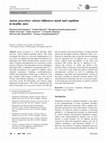
Journal of Natural Medicines, Feb 15, 2017
Apium graveolens is a food flavoring which possesses various health promoting effects. This study... more Apium graveolens is a food flavoring which possesses various health promoting effects. This study investigates the effect of a sub-acute administration of A. graveolens on cognition and anti-depression behaviors via antioxidant and related neurotransmitter systems in mice brains. Cognition and depression was assessed by various models of behavior. The antioxidant system of glutathione peroxidase (GPx), % inhibition of superoxide anion (O 2-), and lipid peroxidation were studied. In addition, neurochemical parameters including acetylcholinesterase (AChE) and monoamine oxidase-type A (MAO-A) were also evaluated. Nine groups of male mice were fed for 30 days with different substances-a control, vehicle, A. graveolens extract (65-500 mg/kg), and reference drugs (donepezil and fluoxetine). The results indicated that the effect of the intake of A. graveolens extract (125-500 mg/ kg) was similar to the reference drugs, as it improved both spatial and non-spatial memories. Moreover, there was a decrease in immobility time in both the forced swimming and tail suspension tests. In addition, the A. graveolens extract reduced lipid peroxidation of the brain and increased GPx activity and the % inhibition of O 2-, whereas the activities of AChE and MAO-A were decreased. Thus, our data have shown that the consumption of A. graveolens extract improved cognitive function and anti-depression activities as well as modulating the endogenous antioxidant and neurotransmitter systems in the brain, resulting in increased neuronal density. This result indicated an important role for A. graveolens extract in preventing age-associated decline in cognitive function associated with depression.

Therapeutic Delivery, May 1, 2011
Background: Excessive accumulation of β-amyloid (Aβ) has been proposed as a pivotal event in the ... more Background: Excessive accumulation of β-amyloid (Aβ) has been proposed as a pivotal event in the pathogenesis of Alzheimer’s disease. Possible mechanisms underlying Aβ-induced neuronal cytotoxicity include excess production of reactive oxygen species (ROS) and apoptosis. We have designed novel nanoparticles, nitroxyl radical-containing nanoparticles (RNPs), which possess nitroxyl radical in the core and chemically scavenges ROS. This study aimed to determine the potential neuroprotective role of RNPs on Aβ-induced cytotoxicity in human neuroblastoma SH-SY5Y cells. Method: SH-SY5Y cells were preincubated with 0.1–1 mM RNP for 24 h and then incubated with 20 µM Aβ1–42 for 48 h. In every group, cell viability, apoptotic rate, ROS levels including superoxide anion radicals and hydroxyl radicals, ROS production including lipid peroxidation, protein oxidation and DNA oxidation were measured. Results: SH-SY5Y cells preincubated with 0.1–2 mM RNP for 24 h were protected from Aβ-induced damage. SH-SY5Y cells preincubated with more than 2 mM RNP for 24 h showed cytotoxicity. From the quantitative analyses, it was observed that RNPs reduced intracellular oxidative stress. RNP treatment significantly reduced the amount of oxidized lipids, proteins and DNA. It also reduced DNA fragmentations, which caused lower apoptosis levels. Conclusion: RNPs are promising intracellular ROS scavengers.
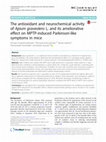
BMC Complementary and Alternative Medicine, Mar 20, 2018
Background: Apium graveolens L. is a traditional Chinese medicine prescribed as a treatment for h... more Background: Apium graveolens L. is a traditional Chinese medicine prescribed as a treatment for hypertension, gout, and diabetes. This study aimed to determine the neuroprotective effects of A. graveolens extract against a Parkinson's disease (PD) model induced by 1-methyl-4-phenyl-1,2,3,6-tetrahydropyridine (MPTP) in C57BL/6 mice. Methods: Male C57BL/6 mice treated with MPTP were orally dosed with A. graveolens extract daily for 21 days. Behavioral tests, including a rotarod apparatus, a narrow beam test, a drag test, a grid walk test, a swimming test, and a resting tremor evaluation, were performed. Thereafter, the mice were sacrificed, and monoamine oxidase A and B activity, lipid peroxidation activity, and superoxide anion levels were measured. Immunohistochemical staining of tyrosine hydroxylase was performed to identify dopaminergic neurons. Results: We found that treatment with A. graveolens at dose of 375 mg/kg demonstrated the highest effect and led to significant improvements in behavioral performance, oxidative stress parameters, and monoamine oxidase A and B activity compared with the untreated group (p < 0.05). Moreover, the extract increased the number of neurons immunopositive for tyrosine hydroxylase expression compared with MPTP alone or MPTP with a positive control drug (p < 0.05). Conclusions: We speculated that A. graveolens ameliorated behavioral performance by mediating neuroprotection against MPTP-induced PD via antioxidant effects, related neurotransmitter pathways and an increase in the number of dopaminergic neurons.

Biomaterials, Nov 1, 2011
The antioxidant effect and potential mechanism of nitroxide radical-containing nanoparticles (RNP... more The antioxidant effect and potential mechanism of nitroxide radical-containing nanoparticles (RNPs) coupled with piperine (PI) were investigated in human neuroblastoma SH-SY5Y cells. The effects of RNP/PI on SH-SY5Y cell lines was determined by WST assay for cell viability, nitroblue tetrazolium and deoxyribose assay for reactive oxygen species generation, ELISA assay for reactive oxygen species products and apoptotic cell death, and biochemical techniques for catalase and glutathione peroxidase activity. The RNP/PI significantly reduced the reactive oxygen species level and reactive oxygen species products compared with those of cells treated with RNPs alone. The RNP/PI treatment enhanced catalase and glutathione peroxidase activity. The combination of RNP/PI has been found to have an augmented antioxidant effect on an Alzheimer&amp;amp;amp;amp;amp;amp;amp;amp;amp;amp;amp;amp;amp;amp;amp;amp;amp;amp;#39;s model in vitro. The mechanism of the protective effect of this combination therapy was correlated in this study with its ability to reduce the generation of reactive oxygen species and prevent apoptosis via scavenging enzyme action pathways.
Foods, Sep 2, 2022
This article is an open access article distributed under the terms and conditions of the Creative... more This article is an open access article distributed under the terms and conditions of the Creative Commons Attribution (CC BY

Journal of Food Biochemistry, Apr 20, 2016
The purpose of this study was to investigate the effects of an Apium graveolens extract (AGE) on ... more The purpose of this study was to investigate the effects of an Apium graveolens extract (AGE) on the arthritis in rats induced using Complete Freund's adjuvant (CFA). Arthritis was induced by injecting CFA into the subplantar of the left hind paws. The AGE (250, 500, 1000 mg/kg) and prednisone 10 mg/kg were given orally at day 5 to day 28 after induction. Treatment of AGE significantly attenuated the severity of CFA-induced arthritis and decreased the arthritis score, paw and ankle thickness. Any histopathological changes were noted. The plasma levels of total peroxide (TP) and oxidative stress index (OSI) were significantly decreased by oral administration of AGE as well as the total antioxidant status (TAS) was significantly increased. Furthermore, oral administrations of AGE remarkably attenuated the increased nitric oxide (NO) levels after induction as was also the myeloperoxidase (MPO) activity in plasma of CFA-induced arthritic rats. Practical Applications Apium graveolens Linn has been consumed as food and traditionally used for inflammatory diseases, gout and rheumatic condition. However, there is no report for pharmacological activity of A. graveolens in the treatment of arthritis. Our results indicate that A. graveolens could alleviate CFA-induced arthritis in rats by decreasing the level of TP, OSI, NO and MPO activity as well as by increasing the level of TAS. Insights from our study may provide the beneficial uses of A. graveolens as a functional food and nutraceutical development for the treatment of rheumatoid arthritis.

Journal of the Science of Food and Agriculture, Oct 16, 2020
BACKGROUNDStroke is a neurological disease caused by a sudden disturbance of cerebral blood flow ... more BACKGROUNDStroke is a neurological disease caused by a sudden disturbance of cerebral blood flow to the brain, leading to loss of brain function. Recently, accumulating lines of evidence have suggested that dietary enrichment with nutritional antioxidants could reduce brain damage and improve cognitive function. In this study, we investigated the possible protective effects of Apium graveolens, a medicinal plant with putative neuroprotective activity, against oxidative‐stress‐related brain damage and brain damage due to inflammation induced by focal cerebral ischemia.METHODSMale adult Wistar rats were administered with an extract of A. graveolens orally 14 days before permanent occlusion of their right middle cerebral artery. The brain infarct volumes of rats in each group were determined by 2,3,5‐triphenyltetrazolium chloride staining, and the density of neurons in the cortex and hippocampus of rats was determined by cresyl violet staining. The levels of malondialdehyde, catalase, glutathione peroxidase, and superoxide dismutase in the cerebral cortex and hippocampus of the rats were also quantified at the end of the study period.RESULTSOur results show that A. graveolens extract significantly decreased infarct volume and improved neuronal density in the cortex and hippocampus of rats receiving A. graveolens extract compared with those rats receiving no treatment. This neuroprotective effect was found to occur partly due to antioxidant, anti‐inflammatory, and anti‐apoptotic effects.CONCLUSIONOur study demonstrates that A. graveolens helps to reduce the severity of cognitive damage caused by focal cerebral ischemia. © 2020 Society of Chemical Industry
Asian Pacific Journal of Cancer Prevention, Dec 1, 2019
activated status of various migratory regulators such as ATP-dependent tyrosine kinase (Akt) is i... more activated status of various migratory regulators such as ATP-dependent tyrosine kinase (Akt) is important for the process of cell movement (Kim et al., 2001; Huang et al., 2005). Numerous studies have demonstrated that the activation of Akt augments the efficiency of migration and invasion of cancer cells (Kim et al., 2001; Scaltriti and Baselga, 2006). Akt localizes at the edge of moving cells interacts with actin-binding proteins and induces actin remodeling and membrane protrusions formation, which subsequently promote cell motility (Kim et al., 2001). Previous studies proved the down-regulation of
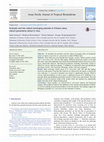
Asian pacific Journal of Tropical Biomedicine, 2017
To elucidate the anxiolytic and free radical scavenging effect of methanolic extract of Apium gra... more To elucidate the anxiolytic and free radical scavenging effect of methanolic extract of Apium graveolens (A. graveolens) in adult C57BL/6 mice. Methods: Sixty male mice were divided into 6 groups: control, vehicle, positive control and A. graveolens (125, 250 and 500 mg/kg). Different behavioral models of elevated plus maze, open field, light/dark, hole-board and pentobarbital-induced sleep were used to assess anxiety-like behavior. Biochemical parameters including monoamine oxidase-A (MAO-A) activity, lipid peroxidation, % inhibition of superoxide anion and glutathione peroxidase activity were measured. Histologic studies were also examined. Results: Mice receiving various doses of A. graveolens (125, 250 and 500 mg/kg) showed an alleviation of anxiety-like behavior as evidenced by the battery of behavioral tests. Likewise, A. graveolens treatment was found to significantly decrease MAO-A activity, lipid peroxidation as well as cause a significant increase of % inhibition of superoxide anion and glutathione peroxidase activity in both cortex and striatum. The total number of survival neurons found in the frontal cortex and striatum was significantly higher than that of the vehicle-treated group. Conclusions: Taken together, we showed that A. graveolens improve the behavioral changes which might be related to the inhibition of free radicals and modulation of MAO-A activity resulting in an increased number of survival neurons. Our findings suggest the therapeutic potential of A. graveolens in the treatment of anxiety.
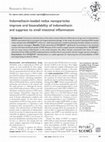
Therapeutic Delivery, 2014
Background: Continuous administration of low-dose nonsteroidal anti-inflammatory drugs such as in... more Background: Continuous administration of low-dose nonsteroidal anti-inflammatory drugs such as indomethacin (IND) is associated with an increased risk of gastrointestinal damage. In this study, the authors developed IND-loaded redox nanoparticles (IND@RNP O) with core-shell-type polymeric micelles possessing nitroxide radicals as reactive oxygen species scavengers. Results: Orally administered IND@RNP O significantly accumulated in the intestinal mucosa and improved blood uptake of IND. Because of the reactive oxygen species-scavenging effect, IND@RNP O did not cause severe inflammation in the small intestine; this effect sharply contrasted with those of orally administered free-IND and IND-loaded polymeric micelles that do not possess reactive oxygen species scavengers. Conclusion: Oral IND@RNP O administration is a useful approach for improving the oral bioavailability of IND and suppressing its adverse effects.
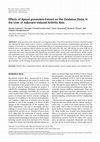
Journal of Food Science and Nutrition, Jun 30, 2016
Apium graveolens Linn. (Apiaceae) is an indigenous plant of the North and South Americas, Souther... more Apium graveolens Linn. (Apiaceae) is an indigenous plant of the North and South Americas, Southern Europe, and Asia and has been widely used as a food or a traditional medicine for treatment of inflammation and arthritis. The purpose of this study was to investigate the antioxidant effects of a methanolic extract of A. graveolens (AGE) against liver oxidative stress in an adjuvant-induced arthritic rat model. The AGE (250, 500, and 1,000 mg/kg) was given orally for 24 consecutive days after induction by injecting complete Freund's adjuvant. Liver and spleen weights were recorded. The superoxide anion level, total peroxide (TP), glutathione peroxidase (GPx) activity, superoxide dismutase (SOD) activity, total antioxidant status, and oxidative stress index (OSI) were also measured. AGE treatment significantly decreased the levels of the superoxide anion, TP, and OSI whereas the GPx and SOD activities significantly increased in the liver of the arthritic rats. These results indicated that AGE showed an ameliorative effect against liver oxidative stress in adjuvant-induced arthritic rats by reducing the generation of liver free radicals and increasing the liver antioxidant enzyme activity.
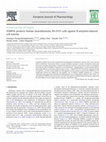
European Journal of Pharmacology, 2011
Amyloid-β peptide (Aβ) has been implicated in the pathogenesis of Alzheimer's disease (AD). It ca... more Amyloid-β peptide (Aβ) has been implicated in the pathogenesis of Alzheimer's disease (AD). It can cause cell death in Alzheimer's disease by evoking a cascade of oxidative damage to neurons. Antioxidant compounds may help to elucidate and develop a treatment for Alzheimer's disease. In the present study, we investigated the protective effect of TEMPOL (4-hydroxy-2,2,6,6-tetramethyl-1-piperidinyloxy), a cyclic nitroxide which is particularly effective at reducing oxidative injury, on Aβ 1-42-induced SH-SY5Y cell toxicity. Exposure of cells to 20 μM Aβ 1-42 for 48 h caused viability loss and apoptotic increase, and pre-treatment with TEMPOL for 24 h significantly reduced the viability loss and apoptotic rate. In addition, TEMPOL inhibited Aβ 1-42-induced superoxide anion generation and hydroxyl radical generation to a striking degree. Based on these results, it is concluded that TEMPOL effectively protects SH-SY5Y cells against β-amyloid-induced damage by suppressing the generation of reactive oxygen species especially, superoxide anion.
Journal of King Saud University - Science, Jul 1, 2023
Uploads
Papers by Pennapa Chonpathompikunlert